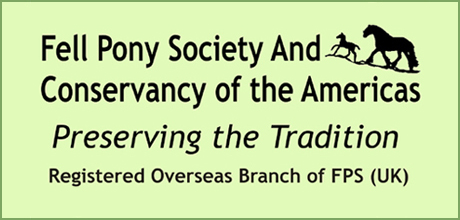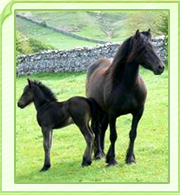
The Fell Pony:
Fell ponies are delightful a medium to large size pony of good temperament & intelligence. Fells are renowned for their ground-covering trot, hairy appearance, and especially their versatility. It has often been said, "You cannot put a Fell to the wrong job!"
ORIGINS
Historically Fell ponies ran in semi-feral herds, & thankfully some still do. Born and raised in mountainous areas, they derive their name "Fell" from the Norse word for "hill". Fells are believed to have originated during Roman times, almost 2,000 years ago in the region which is now the border between England & Scotland.Archaeological evidence supports the presence of several foreign breed types that were believed to have influenced the Celtic pony and thereby shaped many British native pony breeds, including the Fell. The primary influence is considered the now extinct Galloway pony from southern Scotland.
HISTORY
In the North of England, older people will frequently refer to a Fell pony as a galloway (pronounced gallowa')", more specifically Fell gallowas (to distinguish them from Dales gallowas that also used the gallowas as rootstock).
The color of the original ponies reflected their Celtic pony heritage - brown, dun, black and dark bay.
Well maintained roads were rare from the 4th Century until the 18th Century when roads were surfaced again. Therefore packponies were the only reliable means of transporting goods; the Fell was particularly good for this purpose, being a fast & steady walker.
As canals, roads & trains were developed in the 18th & 19th Centuries, the pack ponies were gradually replaced for distance transport, although they were still used locally. In the 19th Century, Fells were utilized for trotting races & sports events, light arable farm work, shepherding, & transport of goods. In the 19th and early 20th century, some Fells were used in County Durham as pit ponies in the coal mines. The smallest ponies worked underground, while the larger ones moved machinery above ground or worked on dairy farms. In some areas Fells were used for 'deer stalking', which required a steady, surefooted pack pony to carry the dead stag down the hills for the hunter.
BREED TRAITS
With strong legs & hooves & plenty of dense flat bone below the knee, they are sturdy, tireless, surefooted, & thrifty. The lay of their shoulder makes them a comfortable long-distance riding mount. Their strength, depth of girth, & soundness of limb & foot, makes them trouble-free competitors for driving, jumping or dressage, & ideal for farm work.
The ideal height for Fells is 13.2 hands; the maximum height imposed is 14 hands. They come in four acceptable colors: Black, brown, bay & gray. A star and/or white on or below the hind fetlock are acceptable. Ponies with excessive white are downgraded to Section X of the Registry.
A Fell is capable of carrying a grown man all day with ease; many are gentle enough for children & with correct training
perfect for the disabled.
Fells are still very easy to maintain, & can work all day on smaller rations where a more highly bred animal would find it hard just to survive.
The Fell breed matures late, often not until seven years. Most Fells in their native country run semi-feral until the age of two or three. Then they are lightly trained & often turned back out until four to five years when they begin light & straight riding, without much bending of their spines. It is suggested that mares not be bred until they are least three years old and have a chance to properly mature.
USEAGE
As a strong but agile pony, Fells are known best for their versatility. While they are still used by some for logging and farming, they are widely used in pleasure and competition disciplines: riding, jumping, endurance, dressage, and driving.
TEMPERAMENT
Fell temperament is like that of other British native ponies strong Native pony survival instinct, intelligence, curiosity, stamina, & mischievousness can pose unique challenges to the inexperienced or unwary person. Sensible training is always essential, but when working with a Fell pony you need to have a cooperative, partnership mentality. Fells, like all equines, are individuals & each can vary in temperament. They are similar to the working dog breeds - they are meant for activities that engage their mind & curiosity.
British author Sue Millard emphasizes the importance of the unseen traits of a native pony; "an even, sensible temperament; hardiness, vigour, self reliance and brains. They're the inner pony, the bits that you only get to know by doing the job & living the life. These invisible characteristics can't be retained without giving the pony a job of work to do &, if possible, allowing it to live & reproduce as its ancestors did & still do."
PRESENTATION
The more natural, the better. Fells should be presented at shows clean & well groomed, yet untrimmed & unadorned, to emphasize their natural state. Leave the whiskers, ear fuzz, and no bridlepaths please! Fells should always be presented, marketed, & promoted as an example of their own breed & not a version of another.
REGISTRATION
All Fells in NA are registered directly in the British FPS Stud Book. The Fell Pony Society (FPS) was formed in 1916. Queen Elizabeth II, a knowledgeable owner & breeder, is its patron today. Her husband, His Royal Highness Prince Philip, competes in driving events with Fells.
CONSERVATION
Today most Fells are still bred in the north of England & southwest Scotland with viable populations throughout the UK, Canada, France, Germany, Holland, Switzerland & the USA.
The challenges of the breed leaving their native fells & being raised & introduced to new environments are elaborated on by Fell author Clive Richardson, "It is relatively easy for a breed to change out of all recognition as a result of environment & not adhering to the original breed standard...By obtaining sound breeding stock, replicating the ponies natural environment as far as possible, maintaining close links with the parent society, using Fells in a wide range of activities, & keeping in mind a clear picture of what a Fell pony should look like, the dangers of breed type being lost are minimized."
Another danger facing this breed is the notion that Fells are a small version of the modern Friesian horse. Misguided perceptions often lead to inappropriate changes in breed type. Fell traits should never be compromised to mimic another breed. While black Fells & Friesians are both hairy, a comparison of conformation, movement, & thinking patterns quickly reveals the differences to horsemen.
The traditional hill breeders of Britain have carefully preserved the ancestral Fell pony type & the hardiness & savvy of the Native pony mountain heritage. In 2008, the total Fell population was NA is around 350. Today, North America has over 650 Fell ponies. Worldwide there are an estimated 6500 registered Fell ponies. The Equus Survival Trust (global) and the Rare Breeds Survival Trust (UK) list them as "endangered."
As Fell pony breeders & enthusiasts, we have a duty to carry on the work of the hill breeders & keep the Fell genetically healthy, while maintaining the original traits of the working type without compromising.
FELL SUPPORT in the AMERICAS
The Fell Pony Society and Conservancy of the Americas is a recognized support group of the FPS, and is a US registered, educational 501(c)(3) nonprofit corporation. Since 1999 the Fell Conservancy has been conserving & promoting the Fell pony within the traditions & vision of the original hill breeders of northern England. Join us in our continued journey to protect the traditional Fell Pony for future generations.

